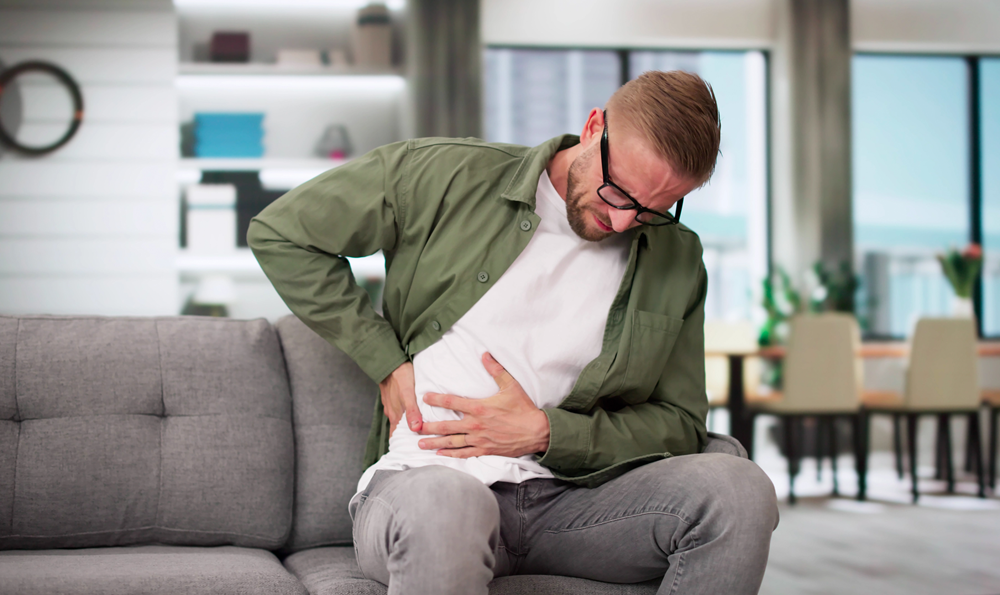You probably learned about your gallbladder in high school biology class. It’s that small, pear-shaped organ located under your liver that stores bile, the liquid made in your liver that helps to break down fats during digestion.
The gallbladder is small, but when diseased — most commonly because of gallstones — it can be quite bothersome.
Klil Babin, MD, a general surgeon at Atlantic Health, explains how gallstones develop, what gallbladder pain feels like and which symptoms signal it’s time to see a doctor.
What are gallstones?
Gallstones are solidified deposits that form in the gallbladder due to an imbalance in the chemical makeup of the bile. Oftentimes, this is caused by an excess of substances such as cholesterol or bilirubin within bile.
“Think of gallstones like the sugar that settles at the bottom of your iced coffee when you’ve added too much,” says Dr. Babin.
Gallstones can be as small as a granule of sugar or grow as large as a golf ball.
Gallstones blocking the gallbladder’s release of bile is the most common cause of gallbladder disease. Gallstones often start with symptoms of biliary colic, which is the medical term for an uncomplicated gallstone attack.
Early signs of gallbladder issues
Dr. Babin says patients often have no symptoms at all from gallstones.
“Very often, we only discover gallstones incidentally through imaging.”
People who do have symptoms commonly experience biliary colic, the pain caused by gallstones.
What does gallbladder pain feel like — and where does it hurt?
People who experience gallbladder-related pain most commonly describe it as an intense pain in the right upper abdomen, just below their ribcage, or even just beneath their breastbone. The pain can also radiate to the right back and spread to the right shoulder.
Typically, the pain appears 30-60 minutes after eating fatty or greasy foods and can last from as little as 30 minutes to up to six hours. Many people confuse the pain with heartburn or indigestion.
Patients should never delay seeking immediate medical attention if there is any concern about a cardiac event due to the overlap in symptoms.
Other symptoms
There are other symptoms that can also represent gallstone disease. These may include:
- Dark brown urine
- Fever or chills
- Light-colored, chalky stool
- Nausea and vomiting
- Sweating
- Yellowing of the skin or eyes (jaundice)
“While pain and sweating are common with gallstone attacks, these other symptoms — fever, jaundice, chalky stool — can signal something more serious and need to be addressed immediately,” says Dr. Babin.
Common causes and triggers of gallbladder problems
The key trigger for gallbladder-related pain is eating fatty foods. Acidic or foods high in protein can also trigger gallbladder pain
Foods high in fat will trigger the gallbladder to squeeze and release bile into the intestine to help break down these fats. Gallstones can interfere with this process by blocking the gallbladder from emptying, which can cause pain.
Risk factors for gallbladder problems
The following factors increase your risk of developing gallbladder problems:
- Being female
- Estrogen hormone therapy
- Gastric bypass and rapid weight loss
- Increasing age
- Oral contraceptives
- Personal or family history of gallstones
- Pregnancy
- Conditions such as obesity, diabetes and hypercholesterolemia (high levels of LDL, the “bad” cholesterol)
- Certain medications, including GLP-1s and those used to treat Crohn’s disease, hemolytic anemia and high triglycerides (fat in blood)
When to see a doctor
Dr. Babin advises anyone with frequent or consistent upper abdominal pain or discomfort, especially after eating fatty foods, to talk to their primary care physician or a gastroenterologist. They can evaluate your symptoms and screen for gallstones with imaging tests and blood work
Once other GI issues are ruled out and an ultrasound confirms gallstones, we’ll refer you to a general surgeon experienced in gallbladder issues.
If your pain is severe, lasting more than six hours, or if you have any of the other more serious symptoms, such as fever and jaundice, go to the ER immediately.
Treatment options for gallbladder issues
The standard treatment for gallstones is gallbladder removal surgery (cholecystectomy).
“Removing the source of the stones is necessary because once you have gallstone-related symptoms, you’re more susceptible to having them again or developing complications,” explains Dr. Babin. “The good news is, you can live without your gallbladder and still have a good quality of life. You don’t have to suffer.”











